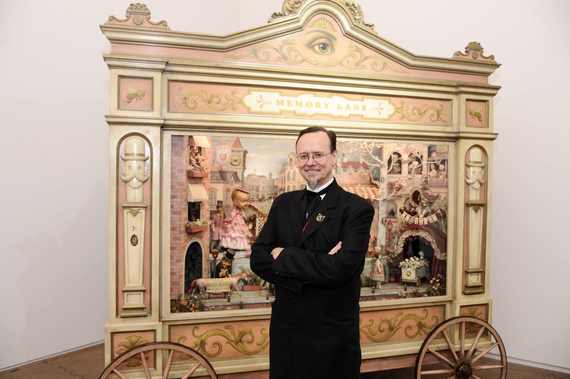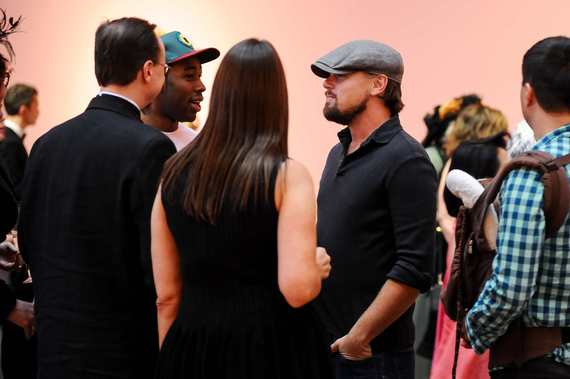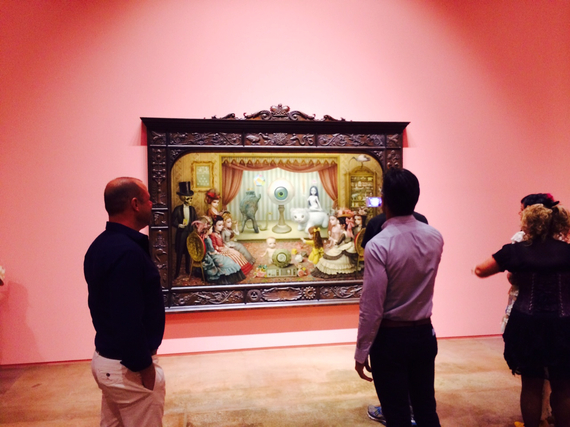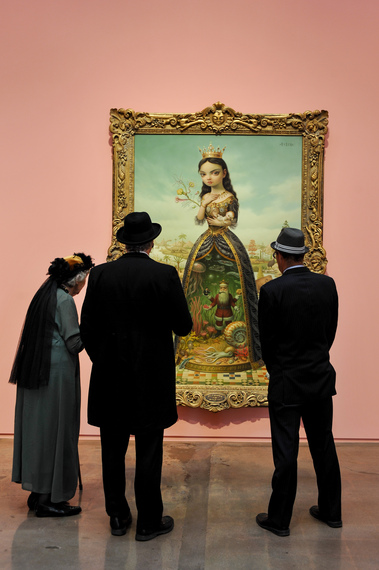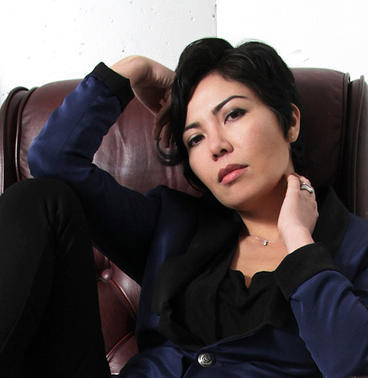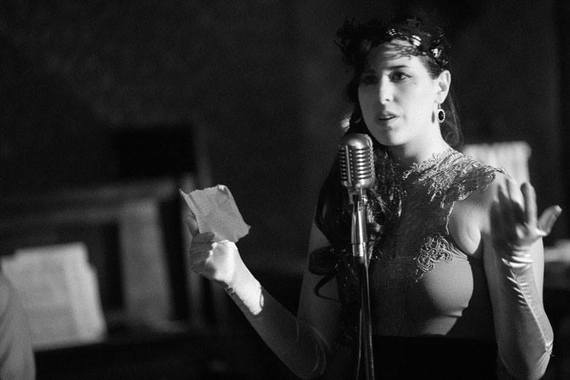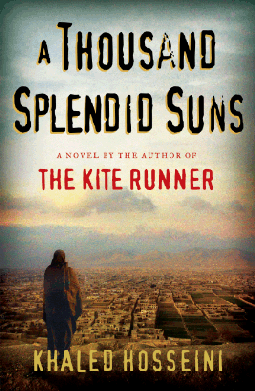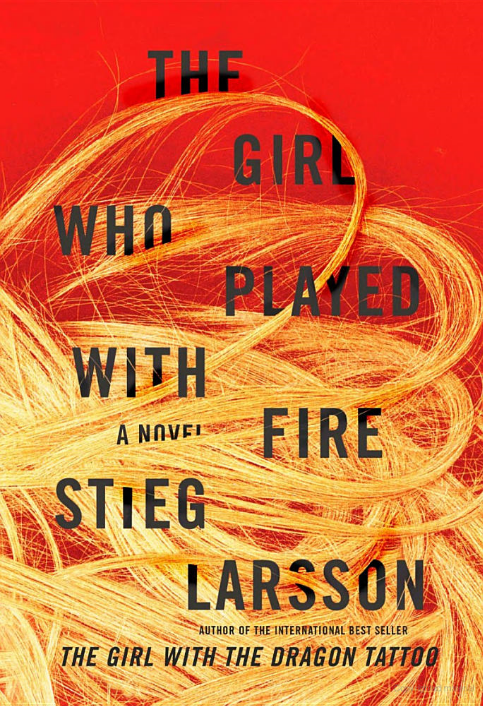The notion of the poetry goddess is as far-reaching as it (she?) is elusive, coy, erudite, and sensual. So much of this construction depends on usage and context -- as is
de rigueur for many things we associate with femininity. The poetry goddess can be both empowering and marginalizing to women who produce and consume poetry; but what or who exactly is the poetry goddess? Is the notion of the poetry goddess, in its simplest form, the idea of The Muse? And if so, why do we feel the need to assign gender to artistic inspiration? Plato kicked the poets out of The Republic, that spitfire Eve got us booted from Eden, and poor, mad Sappho, that erotic dilettante responsible in the Western tradition for giving us lyric poetry, met a horrid fate.
Even in these modern times, the idea that within poetry, traditional versus experimental forms are gendered (traditional attributed to male, as experimental to female) is somewhat of a tired distinction -- an old conversation we had when we burned our bras or whatnot. Still, as in with any movement for change, there are institutional hierarchies in the publishing world that marginalize female voices. Organizations such as
VIDA and
Girls Write Now, feminist presses like
The Feminist Press,
She Writes Press,
Seal, and
Cleis, advocate to close the publishing gap, but do these efforts end up putting women in binders? Haven't we learned that separate -- even when that separateness takes on preternatural qualities is not equal? Who or what is the poetry goddess and what place, if any, does she have in the world of contemporary American poetry? I spoke with some of today's fiercest women poets to try and figure this out.
Who is the poetry goddess?
Wendy Chin-Tanner: Athena? Or Polyhymnia, the Muse of Poetry? Or maybe this question pertains to the idea of the canonized or established female poet. But a goddess is, by definition, immortal, so she couldn't possibly be a real person.
![2014-04-29-WendyChinTanner.jpg]() Rachel Eliza Griffiths:
Rachel Eliza Griffiths: I think Edna St. Vincent Millay would agree if I said she was a poetry goddess. If I said this to Emily Dickinson she might sigh and tell me she found me disappointing. A goddess may be experienced as a fence to render a woman as distant, invisible, perfect, impenetrable, dangerous, and unknowable. For me, the notion of a goddess also plays with the ironic relationship of a woman, her scale or proportion to the world, and how she is observed or valued as Muse.
![2014-04-29-RachelElizaGriffiths.jpg]() Caroline Hagood:
Caroline Hagood: The most liberating and tricky part is figuring out how to be your own muse. That venerated old image of the male poet invoking the muse in some Greek setting has now been replaced by little old me in front of a computer in Brooklyn, wearing pajamas with animals on them, trying to make creative things happen for myself.
Nancy White: The poetry goddess is the collective force of our word-women forebears, calling us forward as writers, and maybe she is also that energy that transcends gender altogether when we are moving deep inside the words themselves.
Is the notion of the poetry goddess helpful to women writers, poets, in particular?
Amy Lemmon: This discussion of male critics or poets arguing that women's poetry or women writing about women's experiences not being as valid is an old discussion, a relic of the 20th century's 'poetess.' I'm thinking of Robert Lowell in his introduction to Plath's posthumously published
Ariel where he writes of her, "Hardly a woman at all, certainly not another 'poetess.'"
Wendy Chin-Tanner: I would agree that the notion of the poetry goddess isn't of much use to me in any of those capacities. Poetry is one of our oldest forms of expression. It's primal and contains elements of the pre-verbal. Poetry attempts to say the unsayable and at its best, poetry wrestles with the contradictions of the human condition with one foot in the gutter and one hand reaching for Parnassus. It is deeply human, embodied, living, and breathing. So why limit the definition of a poet, and a female poet specifically, to something that sounds like a statue on a pedestal?
Lisa Marie Basile: The idea that female poets are writing explicitly feminine poetry is ridiculous. I'm not afraid to write about menstrual blood, but I can, however, write about whatever I want. The poetry goddess is just a lazy construction about women writers.
Miranda Field: Can a notion do much in the way of reparations, for those stuck in the other corner by this culture and this language? I'm not convinced by the power of notions anymore. Notions seem like cake decorations compared with actions.
![2014-04-29-MirandaField150x150.jpg]() Do you identify as a woman poet, or a poet? Is there a difference in the two identities both within the publishing world and your readership?
Caroline Hagood:
Do you identify as a woman poet, or a poet? Is there a difference in the two identities both within the publishing world and your readership?
Caroline Hagood: I've been thinking about this question a lot as I write my dissertation on American women poets. I guess I think of myself as a woman poet in the sense that there are particular subjects I write on that might sound familiar to some women or that may even help them through their day, but not in the sense that I need to be cordoned off from male writers for fear of inferiority or contamination. I hope you can hear humor in that last statement.
Nancy White: I identify as both 'poet' and 'woman poet.' Like so many terms, it really depends on your tone when you say 'woman poet.' I know some who can make the label 'woman poet' sound dismissive, but the range of what women can experience is just so much more extensive than what men experience today. Men's lives in America now, typically, are the ones that are limited and held back by their biology and the confining gender roles, which is a switch, I think, compared to a hundred years ago. Okay, men may still make more money, and that's insane, but their relationships to their bodies and their senses just aren't as complex. Their ability to approach language from so many angles simultaneously is so much less likely to develop early and fully, and their ability to think outside the box can leave them living such narrow lives. So it seems obvious to me that poetry's god is a goddess.
Wendy Chin-Tanner: The poet's individual world is a prism through which we see the universal. In my case, that prism happens to be female and Chinese American. I also identify as a mother, a wife, a daughter, an academic, an editor, a community member, etc., etc. We all have multiple identities, but we have a tendency to reduce people's identities, especially non-mainstream identities, to just a couple of easy labels. We should be very careful of these labels. We should understand that they are not innate or objective, but they in fact function as part of a cultural landscape that's been shaped by money and history and hierarchies of power. The way this plays out in the publishing world is that it can influence which cultural narratives sell, what writers write, and even who gets to write.
Do you feel like you're a confessional poet? Is there any other kind?
Caroline Hagood: The impetus behind my work is to show people they're not alone. Whatever it is, I (or one of my personas) have done it, too, and probably in a more embarrassing manner.
Amy Lemmon: I certainly feel that the persona or 'I' in my poems is not exactly me, the person, though there is a very close correspondence. The term 'confessional poetry' strikes a sour note with many poets -- and in fact M. L. Rosenthal, who coined the phrase to refer to Robert Lowell and Sylvia Plath, among others, was not using it as a compliment.
Nancy White: Yes, to some degree, though I love a great persona poem as well, and probably value image and metaphor over my own story. You do need to let go of the particulars of your story or personal experience in order to "hear" the poem you are creating and help it happen. The tension between the drive to confess (
Me! Me! Me!) and the drive to find out something new is where the poem really starts to happen.
Leah Umansky: My favorite women writers are confessional poets. Of course, there are other kinds. I know tons of poets who do not write about themselves in any shape or form. My first book,
Domestic Uncertainties, is a memoir of my marriage and divorce told through poetry. In my
Mad Men and
Game of Thrones poems, I'm writing about gender and power through the lens of pop culture. Khaleesi and Peggy or Ned Stark and Don Draper take over. But I'm still in there. The poet's always there.
Miranda Field: I really don't like (or maybe understand) the term 'confessional poet,' but I know a name's just a name. I don't consider myself confessional because I think for something you say to be a confession you must feel guilty about it. I think the term 'confessional poet,' though it's definitely used in interesting ways, more properly belongs in another era. But that said, I have to confess I don't like the idea of 'kinds' of poet either.
Rachel Eliza Griffiths: On the page I share so much but I don't feel it comes across as "confessional" in the tradition that Sexton, Plath, or Ginsberg. I'm not interested in dragging other peoples' lives or private relationships into my poems in ways that could be misinterpreted, exploitative, and might be considered harmful or reckless. That doesn't mean I'm not risking my life when I work at a poem. I'm always risking everything.
In a world where we take on personas all the time, how are you separate from your writing?
Miranda Field: 'I' is a near relation, but not she who brushes her teeth with my toothbrush. She's fiercer, more of an ecstatic; at the same time she's stiffer, more dissociated; she's a bit of an underworld dweller; she hits dogs with sticks - I don't do that. She's artificial, made of language and rhythms; and she's more outspoken but more naive than I am, because - I think - she's quite a bit younger. She mixes up fact and subjective truth. She's a false self, an aesthetic veneer, but she's also, at least partly, my own spirit, so she's naked and honest to the point of pain, but she also plays at all times with irony, since she grew up in England, with me. And sometimes wears masks without a thought. I, the writer of 'I', am more guarded, and more conscientious maybe, and I know where a dream ends and daytime begins.
Wendy Chin-Tanner: It's important for my mental health and for my ability to remain productive to maintain a certain level of separation or differentiation from my writing. One of the ways I do that is to view myself as more of a craftsperson than an artist. When I'm making a poem, I do my best to make it as good as I can while it's in my hands, but once I've sent it out into the world, I try to let go of how it might be perceived.
Nancy White: There's a practical answer to that, I suppose: I have to stay organized, pay bills, shop, plan, eat, socialize, work. Very uncreative. But there's another answer, which is really what poets think about: once I start creating, the poem moves outside me, and I can't let my limitations hold it back. I may have to chuck my personal narrative for the good of the poem. I may have to junk the poem because I can't figure out how to enlarge it past my first impetus. I may have to wait and wait to get to the mystery of what in the world is happening in this poem. And all of that requires both pouring yourself into it, and holding yourself back. A paradox that maybe only artists understand?
Amy Lemmon: You have an experience, you deal with it. Going back to Dickinson, 'After great pain a formal feeling comes.' You're living and writing through it. If you're writing about your life, you have to go with the changing course, things happen and that shapes the plot.
Does the notion of the poetry goddess influence how you think readers perceive you or for whom you are writing?
Lisa Marie Basile: When I did a photo shoot to accompany a feature on emerging women poets in the
New York Daily News there were also a lot of people deconstructing the photographs in a such a way that they blamed the poets for presenting themselves as 'sexy' or for acquiescing to the male gaze. When people give attention to female poets for being beautiful, they are limiting the work.
![2014-04-29-LisaMarieBasile.jpg]() Rachel Eliza Griffiths:
Rachel Eliza Griffiths: Some readers want 'real' poems and are simultaneously attracted to and repulsed by confessions, secrets. Ultimately, the poet is the source from which the poem sprouts. I think it's about voice and what gets on your nerves (as a reader).
Caroline Hagood: I like secrets. I'm interested in the bizarre, hilarious, offbeat, the simultaneously funny and sad. I like to write about the things you think and then think you should never tell anyone. That's the juicy stuff. That's what I want to read -- those strange statements that somehow remind you of your deepest self. We do enough presenting of the selves we want the world to see. I like to present the world with selves nobody admits they want to see, but that they want to see most of all. Basically, my ideal reader is a rubbernecker.
Nancy White: I'm having a bit of fun exaggerating here, but probably we owe it to men's growing awareness to kindly refer to them as 'men poets' in a sad, patient voice for, oh, a couple of hundred years. Then maybe the Goddess will share her light with a co-God.
Amy Lemmon: I like to think that I'm writing for my best readers. I'm writing to feel less alone in it and to dispel this moment of solitude.

